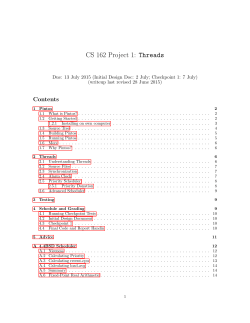
Lecture 1 - Ali Kattan
Ishik University | IT Department/Computer Engineering Department Operating Systems II - Dr. Ali Kattan Lecture 1 Multithreaded Programming: Threads were introduced earlier in the previous course (OS1). The process model introduced in the previous course assumed that a process was an executing program with a single thread of control. Most modern operating systems now provide features enabling a process to contain multiple threads of control. In multithreaded programming we will cover many concepts associated with multithreaded computer systems, including an overview of the APIs for the Pthreads, Win32, and Java thread libraries. We will also cover some issues related to multithreaded programming and its effect on the design of operating systems. Fig. 4.1 single-threaded & multi-threaded processes A thread is a basic unit of CPU utilization; it comprises a • thread ID • program counter • register set • stack. Each thread within a process (multi-threaded) shares with other threads belonging to the same process its • code section • data section • other operating-system resources (such as open files and signals) A traditional (or heavyweight) process has a single thread of control. If a process has multiple threads of control, it can perform more than one task at a time. Figure 4.1 illustrates the difference between a traditional single-threaded process and a multithreaded process. 1 Ishik University | IT Department/Computer Engineering Department Operating Systems II - Dr. Ali Kattan Lecture 1 Many software packages that run on modern desktop PCs are multithreaded. An application typically is implemented as a separate process with several threads of control. For example, think of a word processor such as MS Word (shown below). When you use this program you have several things running at the same time. A word processor may have a thread for displaying graphics, another thread for responding to keystrokes from the user, and a third thread for performing spelling and grammar checking in the background. In certain situations, a single application may be required to perform several similar tasks. For example, a Web server accepts client requests for Web pages, images, sound, and so forth. A busy Web server may have several (perhaps thousands of) clients concurrently accessing it. If the Web server ran as a traditional single-threaded process, it would be able to service only one client at a time, and a client might have to wait a very long time for its request to be serviced. One solution is to have the server run as a single process that accepts requests. When the server receives a request, it creates a separate process to service that request. In fact, this process-creation method was in common use before threads became popular. Process creation is time consuming and resource intensive. If the new process will perform the same tasks as the existing process, this will result in overhead. The OS must keep track of many processes at the same time (scheduling algorithms) and this would usually will increase the load gradually and reduce overall efficiency. It is generally more efficient to use one process that contains multiple threads. 2 Ishik University | IT Department/Computer Engineering Department Operating Systems II - Dr. Ali Kattan Lecture 1 If the Web-server process is multithreaded, the server will create a separate thread that listens for client requests. When a request is made, rather than creating another process, the server will create a new thread to service the request and resume listening for additional requests. This is illustrated in Figure 4.2. Benefits of multithreaded programming: 1. Responsiveness. Multithreading an interactive application may allow a program to continue running even if part of it is blocked or is performing a lengthy operation, thereby increasing responsiveness to the user. Example: Think of your browser when you open several tabs, such multithreaded web browser can allow user interaction in one thread while something else is being loaded in another thread (tab). If for some reason one of the tabs stops responding, the others can still continue execution. You can also terminate only that tab (which is a thread). 2. Resource sharing. Processes may only share resources through techniques such as shared memory or message passing (introduced in OS1). Such techniques must be explicitly arranged by the programmer, which usually requires some effort and skill. However, threads share the memory and the resources of the process to which they belong (see Fig. 4.1). The benefit of sharing code and data is that it allows an application to have several different threads of activity within the same address space. 3. Economy. Allocating memory and resources for process creation is costly. Because threads share the resources of the process to which they belong, it is more economical to create and context-switch threads. 4. Scalability. The benefits of multithreading can be greatly increased in a multiprocessor architecture, where threads may be running in parallel on different processors (introduced in OS1). 3 Ishik University | IT Department/Computer Engineering Department Operating Systems II - Dr. Ali Kattan Lecture 1 Multicore Programming Multicore CPUs were covered in the previous course (OS1). Recall that each of these cores appears as a separate processor to the operating system. For example, the figure below, Fig. 1.7, shows a single CPU with dual-core. The OS will see as two CPUs. Recall also we can also multi-threaded core. For instance, if each core can handle two hardware threads, then the total number of CPUs that the OS will see will be four (logical CPUs). Multithreaded programming provides a mechanism for more efficient use of multiple cores and improved concurrency (concurrency: simultaneously running several tasks). Consider an application with four threads (T1, T2, T3 and T4). On a system with a single computing core, concurrency merely means that the execution of the threads will be interleaved over time (Figure 4.3), since the processing core can execute only one thread at a time. On a system with multiple cores, however, concurrency means that the threads can run in parallel, because the system can assign a separate thread to each core (Figure 4.4). 4 Ishik University | IT Department/Computer Engineering Department Operating Systems II - Dr. Ali Kattan Lecture 1 The trend toward multicore systems has placed pressure on system designers as well as application programmers to make better use of the multiple computing cores. Designers of operating systems must write scheduling algorithms that use multiple processing cores to allow the parallel execution shown in Figure 4.4. For application programmers, the challenge is to modify existing programs as well as design new programs that are multithreaded to take advantage of multicore systems. Multithreading Models As was discussed in the previous course (OS1), the support for threads may be provided either at the user level, for user threads, or by the kernel, for kernel threads. User threads are supported above the kernel and are managed without kernel support, whereas kernel threads are supported and managed directly by the operating system. Virtually all contemporary operating systems—including Windows XP, Windows Vista, Linux, Mac OS X, Solaris, and Tru64 UNIX (formerly Digital UNIX)—support kernel threads. Ultimately, a relationship must exist between user threads and kernel threads. In this section, we look at three common ways of establishing such a relationship. Many-to-One Model The many-to-one model (Figure 4.5) maps many user-level threads to one kernel thread. Thread management is done by the thread library in user space, so it is efficient; but the entire process will block if a thread makes a blocking system call. Also, because only one thread can access the kernel at a time, multiple threads are unable to run in parallel on multiprocessors. One-to-One Model The one-to-one model (Figure 4.6) maps each user thread to a kernel thread. It provides more concurrency than the many-to-one model by allowing another thread to run when a thread makes a blocking system call; it also allows multiple threads to run in parallel on multiprocessors. 5 Ishik University | IT Department/Computer Engineering Department Operating Systems II - Dr. Ali Kattan Lecture 1 The only drawback to this model is that creating a user thread requires creating the corresponding kernel thread. Because the overhead of creating kernel threads can burden the performance of an application, most implementations of this model restrict the number of threads supported by the system. Many-to-Many Model The many-to-many model (Figure 4.7) multiplexes many user-level threads to a smaller or equal number of kernel threads. The number of kernel threads may be specific to either a particular application or a particular machine (an application may be allocated more kernel threads on a multiprocessor than on a uniprocessor). Whereas the many-to-one model allows the developer to create as many user threads as he/she wishes, true concurrency is not gained because the kernel can schedule only one thread at a time. The one-to-one model allows greater concurrency, but the developer has to be careful not to create too many threads within an application (and in some instances may be limited in the number of threads he/she can create). The many-to-many model suffers from neither of these shortcomings: developers can create as many user threads as necessary, and the corresponding kernel threads can run in parallel on a multiprocessor. Also, when a thread performs a blocking system call, the kernel can schedule another thread for execution. 6
© Copyright 2025











